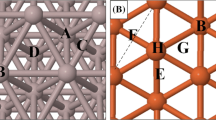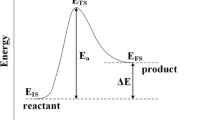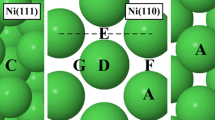Abstract
Combustion and synthesis of hydrocarbons may occur directly (CH → C + H and CO → C + O) or via a formyl (CHO) intermediate. Density functional theory (DFT) calculations were performed to calculate the activation and reaction energies of these reactions on Ni(111), Ni(110), and Ni(100) surfaces. The results show that the energies are sensitive to the surface structure. The dissociation barrier for methylidyne (CH → C + H: catalytic hydrocarbon combustion) is lower than that for its oxidation reaction (CH + O → CHO) on the Ni(110) and Ni(100) surfaces. However the oxidation barrier is lower than that for dissociation on the Ni(111) surface. The dissociation barrier for methylidyne dissociation decreases in the order Ni(111) > Ni(100) > Ni(110). The barrier of formyl dissociation to CO and H is almost the same on the Ni(111) and Ni(110) surfaces and is lower compared to the Ni(100) surface. The energy barrier for carbon monoxide dissociation (CO → C + O: catalytic hydrocarbon synthesis) is higher than that of for its hydrogenation reaction (CO + H → CHO) on all three surfaces. This means that the hydrogenation to CHO is favored on these nickel surfaces. The energy barrier for both reactions decreases in the order Ni(111) > Ni(100) > Ni(110). The barrier for formyl dissociation to CH + O decreases in the order Ni(100) > Ni(111) > Ni(110). Based on these DFT calculations, the Ni(110) surface shows a better catalytic activity for hydrocarbon combustion compared to the other surfaces, and Ni is a better catalyst for the combustion reaction than for hydrocarbon synthesis, where the reaction rate constants are small. The reactions studied here support the BEP principles with R2 values equal to 0.85 for C-H bond breaking/forming and 0.72 for C-O bond breaking /forming reactions.

A density functional theory study of hydrocarbon combustion and synthesis on Ni surfaces







Similar content being viewed by others
References
Higman C, Burgt M (2008) Gasification, 2nd edn. Gulf Professional, Oxfrod
Yazawa Y, Takagi N, Yoshida H, Komai S-i, Satsuma A, Tanaka T, Yoshida S, Hattori T (2002) The support effect on propane combustion over platinum catalyst: control of the oxidation-resistance of platinum by the acid strength of support materials. Appl Catal A 233(1–2):103–112
Anderson RB, Stein KC, Feenan JJ, Hofer LJE (1961) Catalytic oxidation of methane. Ind Eng Chem Res 53(10):809–812
Skoglundh M, Fridell E (2004) Strategies for enhancing low-temperature activity. Top Catal 28(1–4):79–87
Bizzi M, Saracco G, Schwiedernoch R, Deutschmann O (2004) Modeling the partial oxidation of methane in a fixed bed with detailed chemistry. AIChE J 50(6):1289–1299
Horn R, Williams KA, Degenstein NJ, Schmidt LD (2006) Syngas by catalytic partial oxidation of methane on rhodium: mechanistic conclusions from spatially resolved measurements and numerical simulations. J Catal 242(1):92–102. doi:10.1016/j.jcat.2006.05.008
Inderwildi OR, Jenkins SJ, King DA (2007) An unexpected pathway for the catalytic oxidation of methylidyne on Rh{111} as a route to syngas. J Am Chem Soc 129(6):1751–1759
Inderwildi OR, Jenkins SJ, King DA (2008) Mechanistic studies of hydrocarbon combustion and synthesis on noble metals. Angew Chem Int Ed 47(28):5253–5255
Fischer F, Tropsch H (1923) The preparation of synthetic oil mixtures (synthol) from carbon monoxide and hydrogen. Brennst Chem 4:276–285
Dry ME (1996) Practical and theoretical aspects of the catalytic Fischer-Tropsch process. Appl Catal A 138(2):319–344
Schulz H (1999) Short history and present trends of Fischer-Tropsch synthesis. Appl Catal A 186(1–2):3–12
Brady RC, Pettit R (1980) Reactions of diazomethane on transition-metal surfaces and their relationship to the mechanism of the Fischer-Tropsch reaction. J Am Chem Soc 102(19):6181–6182
Brady RC, Pettit R (1981) Mechanism of the Fischer-Tropsch reaction. The chain propagation step. J Am Chem Soc 103(5):1287–1289
Wilson J, de Groot C (1995) Atomic-scale restructuring in high-pressure catalysis. J Phys Chem Us 99(20):7860–7866
Liu Z-P, Hu P (2002) A new insight into Fischer−Tropsch synthesis. J Am Chem Soc 124(39):11568–11569
Ciobîcă IM, Kramer GJ, Ge Q, Neurock M, van Santen RA (2002) Mechanisms for chain growth in Fischer–Tropsch synthesis over Ru(0001). J Catal 212(2):136–144
Klinke Ii DJ, Broadbelt LJ (1999) Construction of a mechanistic model of Fischer–Tropsch synthesis on Ni(111) and Co(0001) surfaces. Chem Eng Sci 54(15–16):3379–3389
Inderwildi OR, Jenkins SJ, King DA (2008) Fischer-Tropsch mechanism revisited: alternative pathways for the production of higher hydrocarbons from synthesis gas. J Phys Chem C 112(5):1305–1307
Andersson MP, Abild-Pedersen F, Remediakis IN, Bligaard T, Jones G, Engbæk J, Lytken O, Horch S, Nielsen JH, Sehested J, Rostrup-Nielsen JR, Nørskov JK, Chorkendorff I (2008) Structure sensitivity of the methanation reaction: H2-induced CO dissociation on nickel surfaces. J Catal 255(1):6–19
Coenen JWE, van Nisselrooy PFMT, de Croon MHJM, van Dooren PFHA, van Meerten RZC (1986) The dynamics of methanation of carbon monoxide on nickel catalysts. Appl Catal 25(C):1–8
Andersson MP, Bligaard T, Kustov A, Larsen KE, Greeley J, Johannessen T, Christensen CH, Nørskov JK (2006) Toward computational screening in heterogeneous catalysis: Pareto-optimal methanation catalysts. J Catal 239(2):501–506
Zhu Y-A, Chen D, Zhou X-G, Yuan W-K (2009) DFT studies of dry reforming of methane on Ni catalyst. Catal Today 148(3–4):260–267
Zhou Y-H, Lv P-H, Wang G-C (2006) DFT studies of methanol decomposition on Ni(100) surface: compared with Ni(111) surface. J Mol Catal A Chem 258(1):203–215
Wang S-G, Liao X-Y, Hu J, Cao D-B, Li Y-W, Wang J, Jiao H (2007) Kinetic aspect of CO2 reforming of CH4 on Ni(111): a density functional theory calculation. Surf Sci 601(5):1271–1284
Goodman DW, Kelley RD, Madey TE, Yates JT Jr (1980) Kinetics of the hydrogenation of CO over a single crystal nickel catalyst. J Catal 63(1):226–234
Hirano H, Tanaka K (1993) Structure and reactivity of carbidic intermediates for the methanation reaction on Ni(100), Ni(111), and Ni(110) surfaces. Stud Surf Sci Catal 75:1575–1578
Hirano H, Tanaka K (1992) A reason for the structure-insensitive catalytic activity of Ni(100) and Ni(111) surfaces for the methanation reaction of CO. J Catal 133(2):461–466
Nørskov JK, Bligaard T, Hvolbæk B, Abild-Pedersen F, Chorkendorff I, Christensen CH (2008) The nature of the active site in heterogeneous metal catalysis. Chem Soc Rev 37(10):2163–2171
Fajín JL, Cordeiro M, Illas F, Gomes JR (2009) Influence of step sites in the molecular mechanism of the water gas shift reaction catalyzed by copper. J Catal 268(1):131–141
Mohsenzadeh A, Bolton K, Richards T (2014) DFT study of the adsorption and dissociation of water on Ni(111), Ni(110) and Ni(100) surfaces. Surf Sci
Henry CR (1998) Surface studies of supported model catalysts. Surf Sci Rep 31(7):231–325
Madix RJ, Gland JL, Mitchell GE, Sexton BA (1983) Identification of the intermediates in the dehydration of formic acid on Ni(110) by high resolution electron energy loss vibrational spectroscopy. Surf Sci 125(2):481–489
Kresse G, Hafner J (1993) Ab initio molecular dynamics for liquid metals. Phys Rev B 47(1):558
Kresse G, Hafner J (1994) Ab initio molecular-dynamics simulation of the liquid-metal–amorphous-semiconductor transition in germanium. Phys Rev B 49(20):14251
Kresse G, Furthmüller J (1996) Efficiency of ab-initio total energy calculations for metals and semiconductors using a plane-wave basis set. Comput Mater Sci 6(1):15–50
Kresse G, Furthmüller J (1996) Efficient iterative schemes for ab initio total-energy calculations using a plane-wave basis set. Phys Rev B 54(16):11169
Perdew JP, Burke K, Ernzerhof M (1996) Generalized gradient approximation made simple. Phys Rev Lett 77(18):3865
Pan Y, Zhang H, Shi D, Sun J, Du S, Liu F, Gao H (2009) Highly ordered, millimeter‐scale, continuous, single‐crystalline graphene monolayer formed on Ru (0001). Adv Mater 21(27):2777–2780
Blöchl PE (1994) Projector augmented-wave method. Phys Rev B 50(24):17953
Monkhorst HJ, Pack JD (1976) Special points for Brillouin-zone integrations. Phys Rev B 13(12):5188–5192
Wang S-G, Cao D-B, Li Y-W, Wang J, Jiao H (2005) Chemisorption of CO2 on nickel surfaces. J Phys Chem B 109(40):18956–18963
Ciobica I, Frechard F, Van Santen R, Kleyn A, Hafner J (2000) A DFT study of transition states for CH activation on the Ru (0001) surface. J Phys Chem B 104(14):3364–3369
Ledentu V, Dong W, Sautet P (2000) Heterogeneous catalysis through subsurface sites. J Am Chem Soc 122(8):1796–1801
Mohsenzadeh A, Borjesson A, Wang J-H, Richards T, Bolton K (2013) The effect of carbon monoxide co-adsorption on Ni-catalysed water dissociation. Int J Mol Sci 14(12):23301–23314
Henkelman G, Uberuaga BP, Jónsson H (2000) A climbing image nudged elastic band method for finding saddle points and minimum energy paths. J Chem Phys 113:9901
Henkelman G, Jónsson H (2000) Improved tangent estimate in the nudged elastic band method for finding minimum energy paths and saddle points. J Chem Phys 113:9978
Fajín JL, Cordeiro M, Illas F, Gomes JR (2010) Descriptors controlling the catalytic activity of metallic surfaces toward water splitting. J Catal 276(1):92–100
Fajín JL, Cordeiro M, Illas F, Gomes JR (2014) Generalized Brønsted–Evans–Polanyi relationships and descriptors for O–H bond cleavage of organic molecules on transition metal surfaces. J Catal 313:24–33
Shojaee K, Montoya A, Haynes BS (2013) Insight into oxygen stability and vacancy formation on Co3O4 model slabs. Comput Mater Sci 72:15–25
Chorkendorff I, Niemantsverdriet JW (2006) Concepts of modern catalysis and kinetics. Wiley, Weinheim
van Harrevelt R, Honkala K, Nørskov JK, Manthe U (2005) The reaction rate for dissociative adsorption of N on stepped Ru (0001): Six-dimensional quantum calculations. J Chem Phys 122:234702
MATLAB R2014a (2013) The Mathworks Inc, Natick
Enger BC, Holmen A (2012) Nickel and Fischer-Tropsch synthesis. Cat Rev 54(4):437–488
Li N, Gaillard F, Boréave A (2008) Electrochemical promotion of Ag catalyst for the low temperature combustion of toluene. Catal Commun 9(6):1439–1442
Wu M, Wang X, Dai Q, Gu Y, Li D (2010) Low temperature catalytic combustion of chlorobenzene over Mn–Ce–O/γ-Al2O3 mixed oxides catalyst. Catal Today 158(3–4):336–342
Catapan RC, Oliveira AA, Chen Y, Vlachos DG (2012) DFT study of the water–gas shift reaction and coke formation on Ni(111) and Ni(211) surfaces. J Phys Chem C 116(38):20281–20291
Li J, Croiset E, Ricardez-Sandoval L (2012) Methane dissociation on Ni(100), Ni(111), and Ni(553): a comparative density functional theory study. J Mol Catal A Chem 365:103–114. doi:10.1016/j.molcata.2012.08.016
Blaylock DW, Zhu Y-A, Green WH (2011) Computational investigation of the thermochemistry and kinetics of steam methane reforming over a multi-faceted nickel catalyst. Top Catal 54(13–15):828–844
Bronsted JN (1928) Acid and basic catalysis. Chem Rev 5(3):231–338
Evans MG, Polanyi M (1938) Inertia and driving force of chemical reactions. Trans Faraday Soc 34:11–24
Wang S, Temel B, Shen J, Jones G, Grabow L, Studt F, Bligaard T, Abild-Pedersen F, Christensen C, Nørskov J (2011) Universal Brønsted-Evans-Polanyi relations for C–C, C–O, C–N, N–O, N–N, and O–O dissociation reactions. Catal Lett 141(3):370–373
Nørskov JK, Bligaard T, Logadottir A, Bahn S, Hansen LB, Bollinger M, Bengaard H, Hammer B, Sljivancanin Z, Mavrikakis M, Xu Y, Dahl S, Jacobsen CJH (2002) Universality in heterogeneous catalysis. J Catal 209(2):275–278
Studt F, Abild-Pedersen F, Bligaard T, Sørensen RZ, Christensen CH, Nørskov JK (2008) Identification of non-precious metal alloy catalysts for selective hydrogenation of acetylene. Science 320(5881):1320–1322
Asthagiri A, Janik MJ (2013) Computational catalysis. The Royal Society of Chem, Cambridge
Abild-Pedersen F, Lytken O, Engbæk J, Nielsen G, Chorkendorff I, Nørskov JK (2005) Methane activation on Ni(111): effects of poisons and step defects. Surf Sci 590(2–3):127–137
Miller SD, Kitchin JR (2009) Relating the coverage dependence of oxygen adsorption on Au and Pt fcc (111) surfaces through adsorbate-induced surface electronic structure effects. Surf Sci 603(5):794–801
Fischer F, Tropsch H (1926) The synthesis of petroleum at atmospheric pressures from gasification products of coal. Brennstoff Chem 7:97–104
Dry ME (2004) FT catalysts. Studies in surface science and catalysis. Elsevier, Amsterdam
Acknowledgments
This research is funded by Stiftelsen Föreningssparbanken Sjuhärad. The computations and simulations were performed on resources provided by the Swedish National Infrastructure for Computing (SNIC) at PDC Centre for High Performance Computing (PDC-HPC) and the Uppsala Multidisciplinary Centre for Advanced Computational Science (UPPMAX). We also acknowledge that the results of this research have been achieved using the PRACE-2IP project (FP7 RI-283493) resource Abel based in Norway at UiO.
Author information
Authors and Affiliations
Corresponding author
Electronic supplementary material
Below is the link to the electronic supplementary material.
ESM 1
(DOCX 54 kb)
Rights and permissions
About this article
Cite this article
Mohsenzadeh, A., Richards, T. & Bolton, K. A density functional theory study of hydrocarbon combustion and synthesis on Ni surfaces. J Mol Model 21, 46 (2015). https://doi.org/10.1007/s00894-015-2590-8
Received:
Accepted:
Published:
DOI: https://doi.org/10.1007/s00894-015-2590-8




